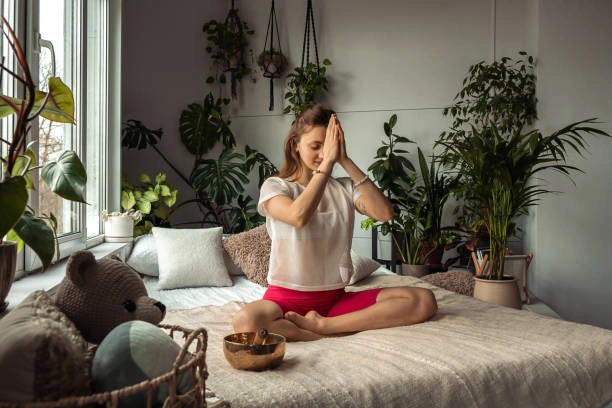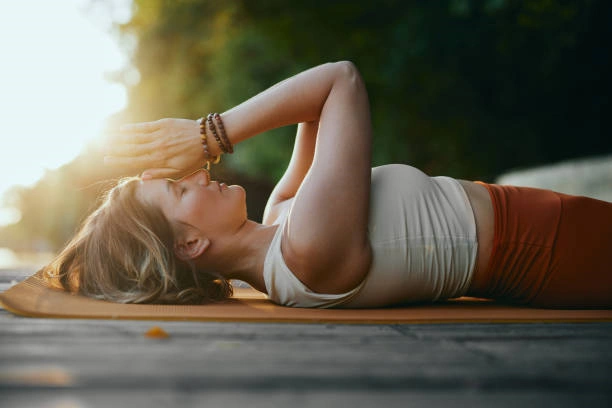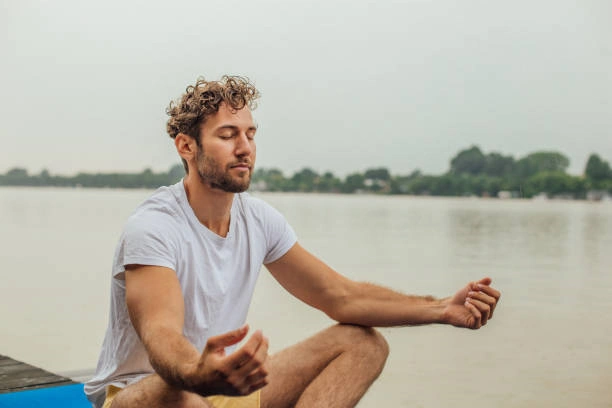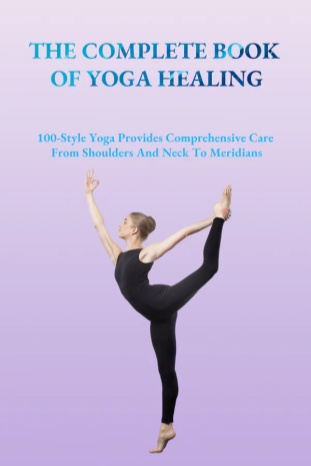10 Common Questions Beginners Face in Meditation
01. What to do if I can’t stop my thoughts during meditation?
When your mind is racing, don’t try to forcefully push your thoughts away; they will leave on their own. If you actively try to eliminate thoughts, you’ll not only fail to remove them, but you’ll also add a new thought of “trying hard to get rid of thoughts.”
It’s normal for thoughts to wander uncontrollably. Just tell yourself to let them be, ignore them, and they’ll disappear soon.
02. How should I breathe during meditation?
It’s generally best to breathe naturally (through diaphragmatic or abdominal breathing) during meditation.
In abdominal breathing, the abdomen rises and falls with each breath. As you inhale, air enters the lower part of your lungs, pushing the diaphragm down and expanding the lungs. As you exhale, the air leaves the lungs, the diaphragm returns, and the abdomen contracts.
Don’t force yourself to correct your breathing. The more natural it is, the less interference you’ll experience, making it easier to enter a meditative state.
For beginners, you can start with slow, deep breaths to calm yourself down. Ideally, your breathing should be even and slow, but if you start feeling pressure from the slow pace, just let it go naturally and focus on awareness instead of the breathing rhythm.

03. What if I fall asleep during meditation?
It’s quite normal to fall asleep, especially if you’re under a lot of stress and rarely get a chance to relax. Don’t fight it—just go with it and take a nap. Sleep during meditation is often of high quality.
For beginners, don’t feel discouraged if you fall asleep, thinking your concentration is weak. Even experienced practitioners sometimes fall into sleep or a half-awake state. Our daily hustle often prevents us from having perfect conditions for every meditation session.
To overcome sleepiness, keep practicing consistently, and over time, you’ll develop your own routine that works for you, free from drowsiness.
04. What posture should I maintain during meditation?
There isn’t a strict rule on posture for meditation. You can meditate sitting, lying down, walking, or standing.
However, sitting is the most commonly used posture, as it provides a stable position and isn’t as likely to lead to falling asleep as lying down.
Sitting positions can vary from cross-legged to kneeling. Cross-legged postures include the full lotus, half-lotus, or simply sitting with legs uncrossed. Choose what feels comfortable for you. The full lotus is the most stable but also the hardest.
When sitting, keep the following in mind:
- Keep your head straight.
- Gently close your eyes and relax your face with a slight smile.
- Place the tongue against the roof of your mouth, just behind the teeth.
- Tuck in your chin slightly.
- Relax and level your shoulders.
- Keep your back straight, without straining or slouching.
Also, two more tips:
- Elevate your hips slightly with a cushion, making it easier to sit straight.
- Avoid sitting directly on the floor to prevent cold air from affecting your knees and legs.
For beginners, closing the eyes can reduce distractions and visual fatigue, but if it makes you sleepy, you can partially open them.

05. Which meditation technique should I use?
Try different meditation techniques to see which ones help you get into the right state more easily. The best meditation method is the one that works for you.
Focusing on your breath is often the first choice for beginners since it’s the most universal and simple technique.
06. When is the best time to meditate?
People often meditate in the morning, midday, or before bed. Morning meditation is often recommended for these reasons:
- You’re full of energy, making it easier to enter a meditative state.
- Morning time is usually less interrupted compared to the evening, making it easier to build a consistent practice.
- Morning meditation can clear your mind and prepare you mentally for the day.
Midday meditation can help if you feel sleepy, as it can boost your rest and refresh your energy for the afternoon.
Evening meditation, although sometimes difficult due to fatigue and mental overload from the day, can improve sleep quality for those who feel relaxed after finishing their day’s tasks.
07. How can I enter a meditative state more quickly?
In the beginning, creating a “ritual” is important. It helps switch your mind into meditation mode quickly. For example, take three deep breaths and tell yourself:
“I’m about to start meditating. For the next period, nothing else matters; I’ll focus only on myself.”
Remove anything that might distract you, like putting your phone on silent. Focus on the exhale, letting your body relax with each breath.

08. Why do my neck and shoulders hurt during meditation?
This usually happens due to poor posture during meditation, or it may be tension accumulated in daily life that you’re not usually aware of. When you focus on yourself in meditation, you become more sensitive to these sensations.
Stretching before meditation can help relax your muscles and prevent tightness during your session.
09. Is meditation about controlling your mind to think about nothing?
Meditation is not about forcing yourself to think of nothing, because “thinking of nothing” is itself a thought.
Instead, meditation helps you avoid being controlled by emotions and thoughts. It teaches you to think and judge calmly, leading to a happier life.
10. Is there a standard for measuring success in meditation?
Meditation is about helping you feel happier and be at peace with yourself. There’s no need to set specific standards for happiness. Throughout life, we’ve been given enough standards to meet. If meditation makes you feel more comfortable in your own situation, that’s already a success.








